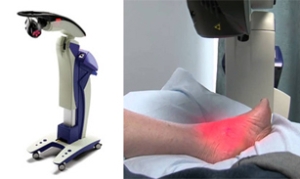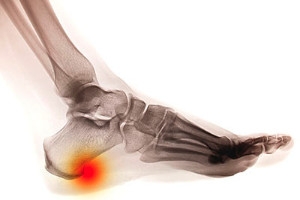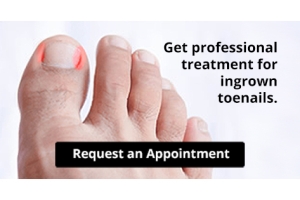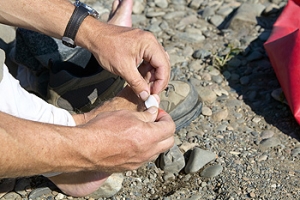
A Laser Treatment for Pain Relief
 Multiwave Locked System known as MLS laser therapy, is a safe, noninvasive and effective treatment for various chronic and acute injuries. MLS uses different wavelengths of light to relieve pain and reduce inflammation in the affected areas. Light energy from the laser penetrates the tissue and enters damaged cells to stimulate cell activity and promote healing. It can be used for many conditions of the foot and ankle, such as tendon and ligament injuries, muscle strains and tears, ligament sprains, sore muscles and joints, neurological pain, and diabetic pain. MLS laser therapy can provide rapid pain relief without negative side effects and soft tissue repair can be stronger and faster. For more information about MLS laser therapy, consult with a podiatrist today.
Multiwave Locked System known as MLS laser therapy, is a safe, noninvasive and effective treatment for various chronic and acute injuries. MLS uses different wavelengths of light to relieve pain and reduce inflammation in the affected areas. Light energy from the laser penetrates the tissue and enters damaged cells to stimulate cell activity and promote healing. It can be used for many conditions of the foot and ankle, such as tendon and ligament injuries, muscle strains and tears, ligament sprains, sore muscles and joints, neurological pain, and diabetic pain. MLS laser therapy can provide rapid pain relief without negative side effects and soft tissue repair can be stronger and faster. For more information about MLS laser therapy, consult with a podiatrist today.
MLS Laser Therapy is a successful alternative for treating any pain you may be experiencing related to certain podiatric conditions. If you are interested in MLS Laser Therapy, consult with one of our podiatrists from William Street Podiatry. Our doctors will assess your condition and provide you with quality foot and ankle treatment.
MLS Laser Therapy
Multiwave Locked System (MLS) Laser Therapy is a patented, FDA-cleared technology that helps relieve pain and inflammation from a number of podiatric conditions, including:
- Heel Pain
- Plantar Fasciitis
- Sports Injuries
- Wounds
- Achilles Tendonitis
- Arthritis
- Neuropathy
- Neuromas
MLS Laser Therapy is an ideal alternative to surgery and prescription medication, as it has no negative side effects and encourages accelerated healing. Among its many clinical benefits, MLS Laser Therapy also:
- Reduces swelling due to bruising or inflammation
- Blocks pain
- Reduces formation of scar tissue
- Improves nerve function
If you have any questions, please feel free to contact one of our offices located in William Street in New York, NY, Forest Hills, NY, and Broadway in New York, NY . We offer the newest diagnostic and treatment technologies for all your foot care needs.
Do I Have a Heel Spur?
 Heel spurs are bony protrusions that develop on the bottom of the heel, and typically form due to an underlying issue such as plantar fasciitis or Achilles tendonitis. Heel spurs tend to form over a long period of time due to damage that pulls on the heel bone. Those who wear high heels, are older, or are very active are at a higher risk for heels spurs. Those who are experiencing heel pain, and possibly a heel spur, should visit a podiatrist right away. A podiatrist can check to make sure that the heel pain isn’t caused by an underlying condition and then provide treatment to manage the pain. In extreme cases, surgery may be required.
Heel spurs are bony protrusions that develop on the bottom of the heel, and typically form due to an underlying issue such as plantar fasciitis or Achilles tendonitis. Heel spurs tend to form over a long period of time due to damage that pulls on the heel bone. Those who wear high heels, are older, or are very active are at a higher risk for heels spurs. Those who are experiencing heel pain, and possibly a heel spur, should visit a podiatrist right away. A podiatrist can check to make sure that the heel pain isn’t caused by an underlying condition and then provide treatment to manage the pain. In extreme cases, surgery may be required.
Heel spurs can be incredibly painful and sometimes may make you unable to participate in physical activities. To get medical care for your heel spurs, contact one of our podiatrists from William Street Podiatry. Our doctors will do everything possible to treat your condition.
Heels Spurs
Heel spurs are formed by calcium deposits on the back of the foot where the heel is. This can also be caused by small fragments of bone breaking off one section of the foot, attaching onto the back of the foot. Heel spurs can also be bone growth on the back of the foot and may grow in the direction of the arch of the foot.
Older individuals usually suffer from heel spurs and pain sometimes intensifies with age. One of the main condition's spurs are related to is plantar fasciitis.
Pain
The pain associated with spurs is often because of weight placed on the feet. When someone is walking, their entire weight is concentrated on the feet. Bone spurs then have the tendency to affect other bones and tissues around the foot. As the pain continues, the feet will become tender and sensitive over time.
Treatments
There are many ways to treat heel spurs. If one is suffering from heel spurs in conjunction with pain, there are several methods for healing. Medication, surgery, and herbal care are some options.
If you have any questions feel free to contact one of our offices located in William Street in New York, NY, Forest Hills, NY, and Broadway in New York, NY . We offer the latest in diagnostic and treatment technology to meet your needs.
How to Treat Heel Spurs
Heel spurs are calcium deposits that cause bone protrusions on the heel bone. Heel spurs are usually associated with plantar fasciitis, which occurs when the plantar fasciitis in the foot becomes inflamed. Typically, heel spurs don’t cause any symptoms. However, they can produce chronic or intermittent heel pain. Those who have had the condition often describe the irritation as a stabbing pain.
There are risk factors that may make you more likely to develop heel spurs. People who have abnormal walking gaits, run and jog on hard surfaces, are obese, or wear poorly fitting shoes are more likely to develop heel spurs.
Fortunately, there are precautions you can take to avoid developing heel spurs. One of the best ways to do this is by wearing well-fitting shoes with shock-absorbent soles. Another preventative technique is to choose running shoes if you plan on running, and walking shoes if you plan on walking. Shoes are made for different activities and it is important to research a shoe before you purchase a pair.
The pain associated with heel spurs often decreases the more you walk. However, a recurrence of pain after an extended period of rest or walking is likely to occur with this condition. Those with severe heel spur pain may opt to go the surgical route for treatment. However, more than 90% of those with the condition get better without surgical treatment. If you have a heel spur and want to know if surgery is right for you, you should go to your podiatrist and he or she will be able to conduct a pre-surgical test or exam to determine if you are an optimal candidate for surgery.
Are You Suffering From Ingrown Toenails?
What Causes Blisters?
 Blisters occur when the skin is stretched too much and the skin cells become fatigued and break apart. After the skin breaks apart, it will naturally fill with fluid as a protective measure. The most common issue that causes these skin breaks is repetitive trauma. Those who run long distances or hike are at a higher risk for developing blisters. When the foot steps forward and the heel hits the ground, the bones in the foot slide forward relative to the skin. Thankfully, the feet can handle a lot of repetitive steps before blisters form, but everyone’s tolerance is different. If you are struggling with blisters it is suggested to check with a podiatrist to see which preventative measures are right for you.
Blisters occur when the skin is stretched too much and the skin cells become fatigued and break apart. After the skin breaks apart, it will naturally fill with fluid as a protective measure. The most common issue that causes these skin breaks is repetitive trauma. Those who run long distances or hike are at a higher risk for developing blisters. When the foot steps forward and the heel hits the ground, the bones in the foot slide forward relative to the skin. Thankfully, the feet can handle a lot of repetitive steps before blisters form, but everyone’s tolerance is different. If you are struggling with blisters it is suggested to check with a podiatrist to see which preventative measures are right for you.
Blisters are prone to making everyday activities extremely uncomfortable. If your feet are hurting, contact one of our podiatrists of William Street Podiatry. Our doctors can provide the care you need to keep you pain-free and on your feet.
Foot Blisters
Foot blisters develop as a result of constantly wearing tight or ill-fitting footwear. This happens due to the constant rubbing from the shoe, which can often lead to pain.
What Are Foot Blisters?
A foot blister is a small fluid-filled pocket that forms on the upper-most layer of the skin. Blisters are filled with clear fluid and can lead to blood drainage or pus if the area becomes infected.
How Do Blisters Form?
Blisters on the feet are often the result of constant friction of skin and material, usually by shoe rubbing. Walking in sandals, boots, or shoes that don’t fit properly for long periods of time can result in a blister. Having consistent foot moisture and humidity can easily lead to blister formation.
Prevention & Treatment
It is important to properly care for the affected area in order to prevent infection and ease the pain. Do not lance the blister and use a Band-Aid to provide pain relief. Also, be sure to keep your feet dry and wear proper fitting shoes. If you see blood or pus in a blister, seek assistance from a podiatrist.
If you have any questions, please feel free to contact one of our offices located in William Street in New York, NY, Forest Hills, NY, and Broadway in New York, NY . We offer the newest diagnostic and treatment technologies for all your foot care needs.
Blisters on the Feet
Blisters are a common ailment of people who wear shoes that are either too tight or rub against the feet in an uncomfortable way. Knowing the basics of blisters is important for understanding how they are formed and what treatments should be used for them.
A blister on the foot, or any other part of the body, is a small pocket that is filled with fluid. It usually forms on the upper layer of the skin because these layers are loose enough to allow a blister to form. The most common fluid in a blister is just a clear, watery-like fluid that usually isn’t cause for concern. However, blisters can fill up with blood if they are deep enough and pus if they have become infected with bacteria.
Blisters almost always form on the feet due to shoes rubbing up against the foot, where the friction causes blisters. These can occur after you have walked for a long period of time or when your shoes do not fit you properly. Your feet are also more prone to blisters if they are moist, so keeping them dry and clean is one preventative step you can take.
Preventing infection should be the number one concern when treating blisters, as well as relieving the pain they can cause. Using a bandage to cover up the blister will help it heal and prevent bacteria from entering it. New skin will form under the blister and eventually cause it to pop. You can also take a sterilized pin and try to pop it yourself.
If the blister is filled with pus or blood, seeking treatment from a doctor is ideal. Antibiotics may need to be taken in order to completely eliminate the bacteria inside the blister. See a doctor to have an antibiotic prescribed.
The best way to treat blisters is to prevent them all together. Keeping your feet dry and making sure that your shoes fit properly are just two of the steps you can take to prevent blisters. Shoes that are too tight or shoes that are too loose and allow your feet to slide in them will cause blisters. Applying a bandage to an area where you think a blister is about to form is another way you can prevent them.
Are Flip-Flops Failing My Feet?
 Flip-flops are a staple of summer footwear, especially at the beach or pool. However, wearing flip-flops may do more harm than good for the health of your foot. If you frequently wear flip-flops, you may notice that you have to constantly flex your toes to keep the shoes firmly on your feet. This toe flexing can lead to bunions and hammertoes, conditions that disfigure the joints of your toes. Flip-flops also provide very little support to your feet while you walk, potentially increasing your likelihood of foot and heel pain, especially if you have flat feet or fallen arches. Since flip-flops increase your feet’s exposure to the elements, you may also be at risk for developing fungal infections, like athlete’s foot and toenail fungus. If you must wear flip-flops, you may be able to avoid damage to your feet by wearing them only for short periods of time. For more information on the effects of flip-flops on your feet, and for treatment of any foot condition, consult with a podiatrist today.
Flip-flops are a staple of summer footwear, especially at the beach or pool. However, wearing flip-flops may do more harm than good for the health of your foot. If you frequently wear flip-flops, you may notice that you have to constantly flex your toes to keep the shoes firmly on your feet. This toe flexing can lead to bunions and hammertoes, conditions that disfigure the joints of your toes. Flip-flops also provide very little support to your feet while you walk, potentially increasing your likelihood of foot and heel pain, especially if you have flat feet or fallen arches. Since flip-flops increase your feet’s exposure to the elements, you may also be at risk for developing fungal infections, like athlete’s foot and toenail fungus. If you must wear flip-flops, you may be able to avoid damage to your feet by wearing them only for short periods of time. For more information on the effects of flip-flops on your feet, and for treatment of any foot condition, consult with a podiatrist today.
Flip-flops are not always the best choice of footwear. If you have any concerns about your feet or ankles, contact one of our podiatrists from William Street Podiatry. Our doctors will assist you with all of your foot and ankle needs.
Flip-Flops and Feet
When the weather starts warming up, people enjoy wearing flip-flops. Flip-flops are comfortable, stylish, and easy to slip on and off; they're perfect for any summer beach goer. However, these shoes can cause harm to the feet.
How Can Flip-Flops Affect Me Long-Term?
- Ankle problems
- Hip problems
- Lower back problems
- Pain in the balls of the feet
- Problems with foot arches
- Changes in the way you walk
Are There Injuries Associated with Flip-Flops?
Yes. Since flip-flops are relatively weak and do not provide the same amount of support as sneakers, people who wear flip-flops regularly are more susceptible to injuries. On top of that, the open nature of the shoe makes your feet more prone to other problems, such as cuts and even infections. Common injuries and ailments include:
- Sprained ankles
- Blisters
- Infections
- Cuts and Scrapes
I like Wearing Flip-Flops. Are There Safe Alternatives?
When buying flip-flops, try to find ones that have sturdy soles and that are made of high-quality materials that will support for your feet. These flip-flops will cost more but will also last longer as a result.
If you have any questions please feel free to contact one of our offices located in William Street in New York, NY, Forest Hills, NY, and Broadway in New York, NY . We offer the newest diagnostic and treatment technologies for all your foot and ankle needs.
Flipping Out About Flip Flops
Although it may be tempting to wear flip-flops in warm weather, they are not the best choice of footwear for your feet. Flip-flops may be ideal for the beach, pool, spa, and shared showers, but you should avoid wearing them unless it is completely necessary.
Flip-flops only have a small strip of fabric holding your foot in place, but your toes need a better grip to keep your foot in place. The repetitive gripping can lead to an overuse of your muscles, which could result in tendinitis. This is only one of the many problems that stem from wearing flip-flops too often.
Flip flops aren’t good for extensive walking because they fail to offer arch support, heel cushioning, or shock absorption. As a result, people who wear flip flops are at a higher risk of experiencing an ankle sprain. Additionally, these shoes offer little protection for your feet, putting those who wear them at a greater risk for stubbed toes, glass cuts, and puncture wounds.
Although flip flops aren’t recommended for everyday use by anyone, it is especially important for diabetics to avoid them. A diabetic foot injury can easily become very serious, and it may even lead to amputation.
If you are experiencing pain from wearing flip-flops, you shouldn’t be hesitant to replace them with a more comfortable shoe that offers more support. If your flip-flop foot pain doesn’t go away, you should seek assistance from a podiatrist right away. It is possible that you may have a more serious foot problem such as a stress fracture or arthritis.
Risk Factors for Toenail Fungus
 A toenail fungus is not only unsightly, but it may be painful as well. There are many potential risk factors that increase the chances of developing a toenail fungus. Being aware of these risks may help to limit your exposure. If you have a family history of toenail fungus, it is important to monitor your toenails frequently. Other risk factors are shoes, particularly boots, that do not provide proper ventilation, which creates a warm and humid environment for fungi to thrive in. Heavy nail polish prevents light from reaching the toes and increases the risk as well. Additionally, one of the most common places for catching a toenail fungus is a locker room due to the humidity. If you believe that you may have developed a fungal nail infection, it is important to consult with a podiatrist for proper treatment.
A toenail fungus is not only unsightly, but it may be painful as well. There are many potential risk factors that increase the chances of developing a toenail fungus. Being aware of these risks may help to limit your exposure. If you have a family history of toenail fungus, it is important to monitor your toenails frequently. Other risk factors are shoes, particularly boots, that do not provide proper ventilation, which creates a warm and humid environment for fungi to thrive in. Heavy nail polish prevents light from reaching the toes and increases the risk as well. Additionally, one of the most common places for catching a toenail fungus is a locker room due to the humidity. If you believe that you may have developed a fungal nail infection, it is important to consult with a podiatrist for proper treatment.
If left untreated, toenail fungus may spread to other toenails, skin, or even fingernails. If you suspect you have toenail fungus it is important to seek treatment right away. For more information about treatment, contact one of our podiatrists of William Street Podiatry. Our doctors can provide the care you need to keep you pain-free and on your feet.
Symptoms
- Warped or oddly shaped nails
- Yellowish nails
- Loose/separated nail
- Buildup of bits and pieces of nail fragments under the nail
- Brittle, broken, thickened nail
Treatment
If self-care strategies and over-the-counter medications does not help your fungus, your podiatrist may give you a prescription drug instead. Even if you find relief from your toenail fungus symptoms, you may experience a repeat infection in the future.
Prevention
In order to prevent getting toenail fungus in the future, you should always make sure to wash your feet with soap and water. After washing, it is important to dry your feet thoroughly especially in between the toes. When trimming your toenails, be sure to trim straight across instead of in a rounded shape. It is crucial not to cover up discolored nails with nail polish because that will prevent your nail from being able to “breathe”.
In some cases, surgical procedure may be needed to remove the toenail fungus. Consult with your podiatrist about the best treatment options for your case of toenail fungus.
If you have any questions, please feel free to contact one of our offices located in William Street in New York, NY, Forest Hills, NY, and Broadway in New York, NY . We offer the newest diagnostic and treatment technologies for all your foot care needs.
Treating Toenail Fungus
Fungal infection of the toenail, or onychomycosis, typically appears as a gradual change in a toenail’s texture and color that involves brittleness and darkening. The fungal infection itself occurs beneath the surface of the nail. Aside from discoloration, other symptoms include the collection of debris beneath the nail plate, white marks on the nail plate, and a foul odor emanating from the nail. If ignored, the infection can spread into other nails and the skin; in severe cases, it can hinder one’s ability to work or walk.
The toenails are particularly vulnerable to contracting infection in moist environments where people are likely to be walking barefoot, such as around swimming pools, public showers, and locker rooms. Fungal infection may also be more likely to occur in nail beds that have been injured, and sufferers of chronic diseases such as diabetes, circulatory problems, or immunodeficiency conditions are particularly prone to developing fungal nails.
Fungal nails can be primarily prevented by practicing proper hygiene and regularly examining the feet and toes. Carefully washing the feet with soap and water and thoroughly drying the feet afterwards are essential. Other tips include wearing shower shoes in public areas, changing shoes and socks daily, keeping toenails clipped at a short length, wearing breathable shoes that fit properly, wearing moisture-wicking socks, and disinfecting home pedicure tools and instruments used to cut nails.
Fungal nail treatment may vary between patients and the severity of the condition. Your podiatrist may suggest a daily routine of cleansing that spans over a period of time to ease mild infections. Over-the-counter or prescription antifungal agents may also be prescribed, including topical and/or oral medications. Debridement, or the removal of diseased nail matter and debris, may also be performed. In more severe cases, surgical treatment may be needed. In some instances, the temporary removal of the fungal nail allows for the direct application of a topical antifungal to the nail bed. In other cases, a chronically painful fungal nail that has not responded to other treatments may be permanently removed; this allows the infection to be cured and avoids the growth of a deformed nail.








